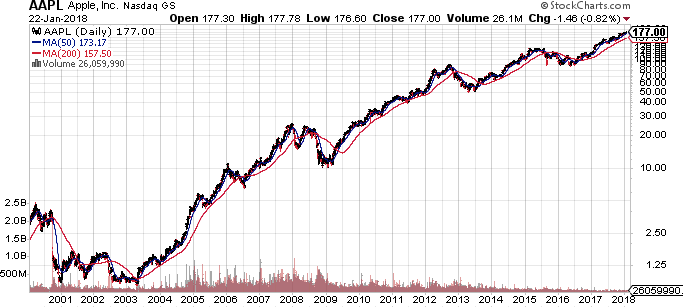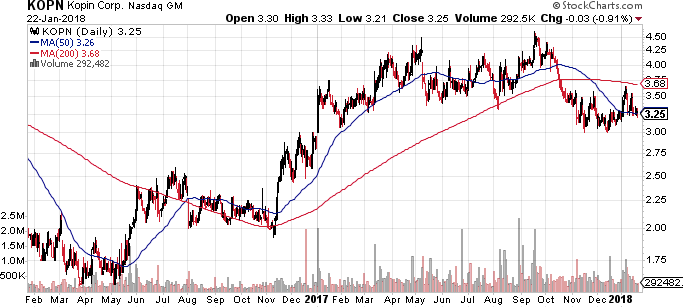Why Apple’s $3 Darling Could Explode by 9,000%
Apple is one of the biggest companies in the world – a $908.7 billion behemoth

So when its CEO says, “It’s going to change everything,” it’s a good idea to pay close attention or miss out on what could produce a 9,000% return.
Think about it. Every $500 could be worth $45,500.
Every $5,000 invested could be worth $455,000.
Every $10,000 could be worth $910,000.
By now you’re familiar with augmented reality (AR).
Or, reality that can blur the line between what’s real and what’s actually computer-generated simply by enhancing what we see, hear, feel and even smell. Unlike virtual reality, which creates computer-generated environments, augmented reality can create what’s known as near-real world reality. Take a look at Pokemon Go, for example, which in 2016 generated some $950 million after being downloaded 500 million times.
All of a sudden, cities around the world saw their streets flooded with people trying to catch Pokemon with their smartphones. When one appeared on the screen, the user threw virtual Poke Balls at it until its captured. Others are using augmented reality to see how a couch may fit in a room before actually buying it, or trying on a pair of glasses without physically trying them on.
No wonder Tim Cook is so excited.
He believes augmented reality could change the way we work, play, connect and learn.Cook strongly believes that transformative power of augmented reality could change the way we work, play, connect and and learn. Even research firm IDC believes the market could explode by 180% over the next three years to nearly $162 billion from $5 billion.
Facebook, Alphabet, Google, and Sony, are pursuing AR with hardware and software, investing billions of dollars into headsets that help users experience virtual worlds. Facebook’s Oculus just touted new features at The International Consumer Electronics Show (CES).
Google and Lenovo just showed off a new AR headset.
HTC announced an updated version of Vive with better graphics, too. Even more exciting, at CES 2018, major players – like Facebook, Apple and Google – were meeting with suppliers that make the nuts and bolts required to power AR glasses.
But what’s also really exciting is that Apple CEO Tim Cook is still talking up the potential of AR. He’s making the case for mainstream consumer applications.
In fact, according to a new Bloomberg Business Week article, Cook says:
I think it is profound. I am so excited about it, I just want to yell out and scream. The first step in making it a mainstream kind of experience is to put it in the operating system. We’re building it into iOS 11, opening it to developers—and unleashing the creativity of millions of people. Even we can’t predict what’s going to come out. There’s some things that you can already get a vision of. We’ve talked to IKEA, and they have 3D images of their furniture line. You’re talking about changing the whole experience of how you shop for, in this case, furniture and other objects that you can place around the home. You can take that idea and begin to think this is something that stretches from enterprise to consumer.There’s not a lot of things that do that.
You’ll see things happening in enterprises where AR is fundamental to what they’re doing. You’re going to see some consumer things that are unbelievably cool. Can we do everything we want to do now? No. The technology’s not complete yet. But that’s the beauty to a certain degree. This has a runway. And it’s an incredible runway. It’s time to put the seat belt on and go. When people begin to see what’s possible, it’s going to get them very excited — like we are, like we’ve been.
These days, all eyes are on Apple, which considers AR to be a revolutionary as the smartphone. “Put simply, we believe AR is going to change the way we use technology forever,” says Cook, which could have the technology ready for launch no late than 2019.
If that’s not enough to get you excited, consider the Apple AR dream team.
- Jeff Norris joined the team from NASA’s Jet Propulsion Lab
- Avi Bar-Zeev was in charge of the original Microsoft Holo Lens
- Mike Rockwell, who was an executive VP in Dolby Labs’ Advanced Technology Group
- Doug Bowman, a director for the Centre for Human Computer Interaction at Virginia Tech
- Tomlinson Holman, an audio pioneer who invented THX sound system
- Zeya Li, an engineer in computer vision
- Yury Petrov, a research scientist from Facebook’s Oculus VR
That’s quite a team assembled to create Apple’s AR glasses.
Better yet, according to International Business Times:
“Just recently the European Patent Office published a new patent application from Tim Cook’s company, and it is one that details Apple’s plans for its augmented reality glasses. Based on the published document, Apple’s AR glasses could include near-eye displays that are designed to project images close to the user’s eyes. Patently Apple reports that the patented technology could mean that Apple is developing devices like virtual reality and augmented reality headsets that come with near-eye displays. The devices are said to come with optical elements that would make it possible for wearers to easily and comfortably view what is being shown in the displays.”
“The implementation of a near-eye display could be pretty challenging. But if done well, Apple could be offering consumers with a very advanced head-mounted device that would allow users to view computer-generated images and real-world objects simultaneously.
This could then offer a whole new way for users to view their surrounding environment. Apple’s near-eye display system, as detailed in the patent application, has a complex structure comprising microprocessors, digital signal processors, image processors, flash storage, read-only memory, random-access memory, various sensors, voice input and even speakers. There’s also mention of wireless circuitry for communication purposes.”
The question now is – how can we profit from it.
Of course, one way is to just buy shares of Apple. But we’ve found a small $244.8 million company with a $3.25 stock that could turn your $5,000 into $455,000.
Kopin Corporation (NASDAQ:KOPN)
Kopin Corporation invents, develops, manufactures, and sells wearable technologies and display products in the United States, the Asia-Pacific, and Europe. The company’s Kopin Wearable technology includes component technologies, which can be integrated to create products and proprietary headset systems, which use voice as the primary user interface and through the use of wireless technologies can contact other users, devices, or information from the cloud.

It provides components, including high-density color or monochrome miniature active-matrix liquid crystal displays, liquid crystal on silicon displays, application specific integrated circuits, backlights, optical lenses, and audio integrated circuits, as well as offers headset systems. The company’s display products are used in military, consumer, electronic, and industrial products, such as thermal weapon sights, digital cameras, virtual and augmented reality gaming, training and simulation products, and metrology tools.
One of the reasons we like KOPN here is because of Apple’s patent mention of near-eye displays, which KOPN specializes in. In fact, according to a December 2016 press release:
“Most mobile virtual reality (VR) systems use smartphone-size panels on glass and large optics, resulting in bulky, heavy, power hungry solutions. In addition, the display resolution of the smartphone panels is not sufficient for the large field of view required for VR, resulting in poor image quality with screen door effect. OLED microdisplays based on Si backplane are much smaller, yet offer higher resolution, and use more compact optics, providing the potential for smaller, lighter, more power efficient VR headset solutions with smooth image and low latency.
Recognizing this value proposition, Kopin has developed a novel silicon backplane structure to drive high-speed OLED-on-silicon microdisplays for truly immersive VR systems without those size, weight and power constraints of today’s direct view products. Kopin’s OLED microdisplay, protected by 10 patents pending, is an ultra high resolution, high speed, low power and small form factor display that delivers a superior user experience for mobile and wearable systems. OLED-on-silicon microdisplays consist of two key elements: the silicon backplane and the OLED emissive layer. What is unique about Kopin’s business model is that both of these manufacturing operations are outsourced to dedicated foundries, while the design expertise resides within Kopin. It is the first fully fabless OLED microdisplay business model.
“Kopin has been one of the largest and most successful suppliers of microdisplay systems with over 30 million AMLCD and LCOS products shipped,” said Dr. John C.C. Fan, Kopin’s CEO and founder. “With the addition of OLED microdisplays and modules to our product portfolio, we now offer our customers a variety of display technologies and optics, enabling our customers to evaluate different designs to create the optimal product of their targeted application.”
These are very exciting times for augmented reality, especially if Apple is involved.
Buy shares of Kopin Corporation (KOPN) and sit tight. It should be a fun ride.
